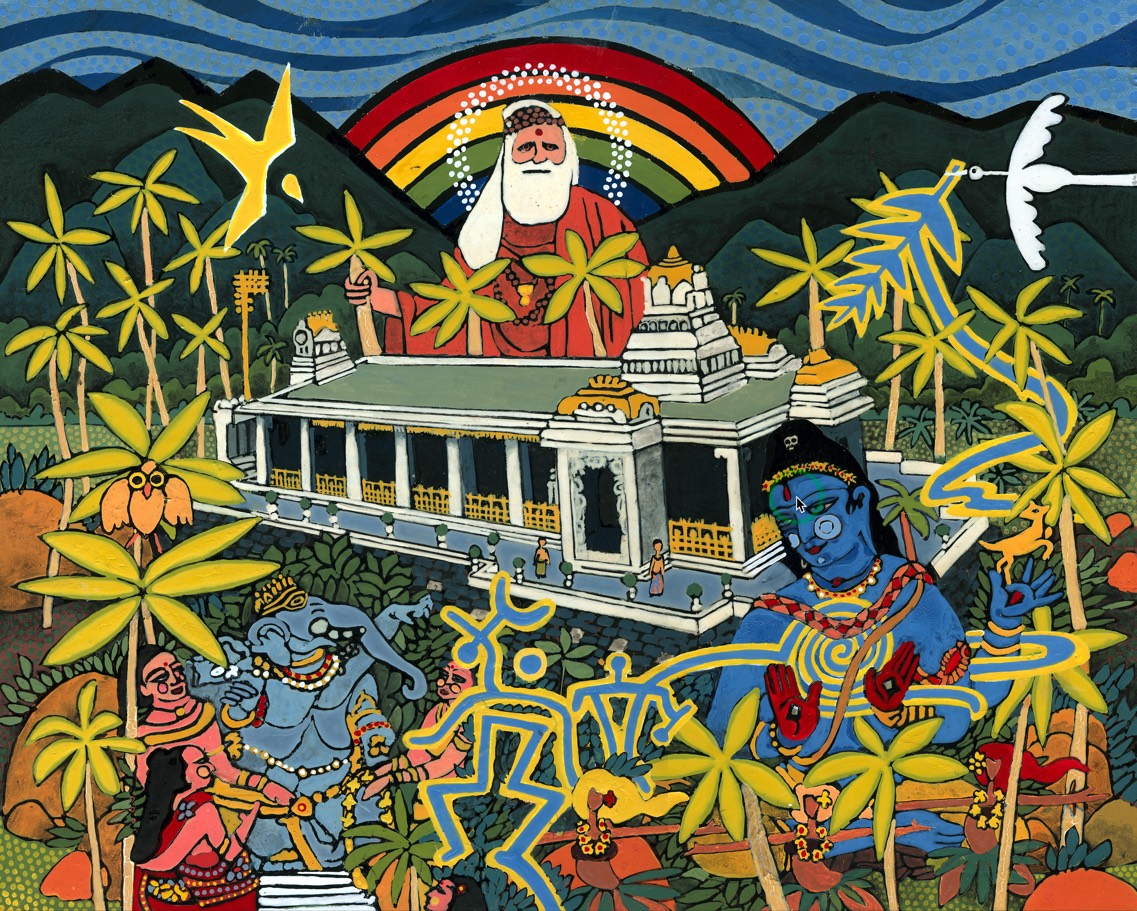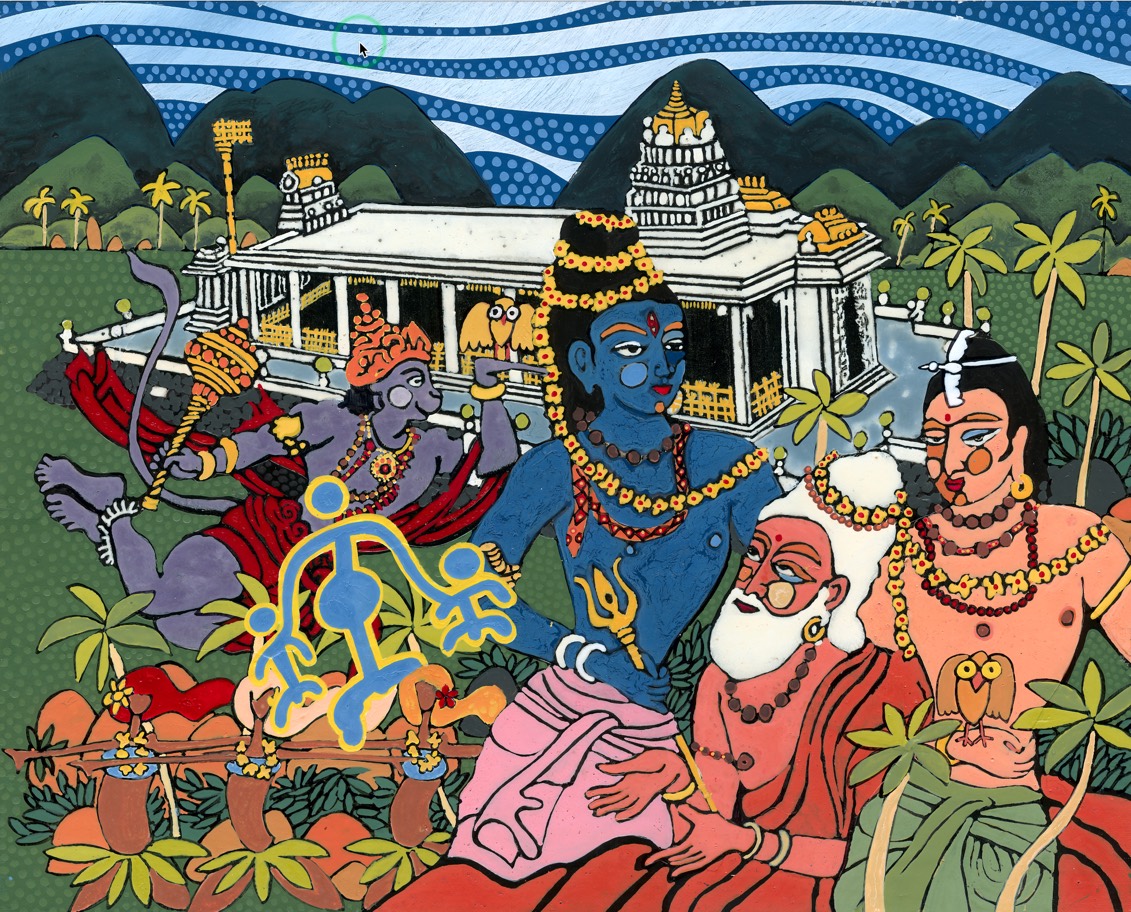Unqualified Surrender

Kauai’s Iraivan Temple (#2) by Derick Glaskin
What do we mean by internalizing worship? In external worship we are trying to see God and communicate with God with our two eyes and our physical nerve system. We enjoy His darshan and feel His śakti. In deep meditation, the external worship is deliberately internalized, and we are trying to see God with our third eye and feel God’s all-pervasiveness through our psychic nerve system. Externalizing bhakti is really much easier than internalizing it. But once the externalized bhakti is perfected, it will be easy and natural to internalize bhakti right along. When this is accomplished, the most rigorous hurdles and time-consuming practices of yoga, which often lead the person onto āṇava mārga, will have been side-stepped. ¶To internalize worship, after the pūjā is over sit before the Deity and draw into yourself all the prāṇas you feel around your body. Then draw those energies up the spine into the head. This is done with the mind and with the breath. It is very easy to do. It is especially easy when one is at the end of a major karmic cycle. The bhakti of uncompromising surrender, prapatti, to the God during a temple pūjā awakens the amṛita. The amṛita is the sweet essence from the sahasrāra chakra. It is the binding yoke to the Divine. Bind yourself in the lotus posture after temple worship and simply internalize all the feeling that you had for the God during the worship. That’s all there is to it. The yogī yoked within enjoys the amṛita that flows from the cranium throughout his body. Devotees who want to awaken the higher chakras and sustain that awakening on the safe path will throw themselves into becoming uncompromising bhaktars. Then all the Gods of all three worlds will open their hearts and shower their blessings upon them. ¶What is my advice for those who find such uncompromising surrender hard to imagine but realize it is their next step on the path? Go on a pilgrimage once a year, read scriptures daily, perform pūjā daily, go to the temple at least once a week, if not more often—fulfill these disciplines, known as the pañcha nitya karmas. This is the basic Śaiva Siddhānta sādhana. ¶But on another level, one will not be able to fulfill the pañcha nitya karmas if he or she is not fulfilling the yamas and the niyamas, for these are the character-builders. We must possess a good character to be successful in bhakti yoga. Therefore, begin at the beginning. Right thought produces right speech, which produces right action. Right thought is produced through the knowledge of dharma, karma, saṁsāra and the all-pervasiveness of God. This knowledge correctly understood disallows the devotee from having wrong thoughts. He simply has right thought, and of course, right speech and action follow naturally. ¶Śaiva Siddhānta extols the guru and says that when the student is ready, one will appear. The guru will always restate the dharma to a devotee who is having problems with bhakti yoga practices. He will always direct the mind to the beginning teachings, for it would be obvious that the student does not understand one or more of them. If the devotee is not following the pañcha nitya karmas or the yamas and niyamas, it is obvious that purified knowledge of these four areas—dharma, karma, saṁsāra and Śivaness—needs to be strengthened. ¶Individual practices to advance spiritual unfoldment include prostrating before God, Gods and guru, full body, face down, arms and hands outstretched, and in that act, total giving up, giving up, giving up, giving up. In Sanskrit it is called prāṇipāta, “falling down in obeisance.” What are these devoted ones giving up? By this act they are giving the lower energies to the higher energies. It is a merger, a blending. When one is performing this traditional devotional act, awakening true prapatti, it is easy to see the lower energies from the base of the spine, the mūlādhāra chakra, rising, rising, rising up the spine through all six chakras above it and out through the top of the head. It is transmuting, changing the form of, the base energies which breed conflict and resistance, “mine and yours” and “you and me,” division, insecurity and separateness, into the spiritual energies of “us and we,” amalgamation, security, togetherness. ¶Once the giving up of the lower is total—body and face on the ground, hands outstretched before the image of God, Gods or guru—those energies are surrendered into the higher chakras within the devotee, and it is a blissful moment, into the consciousness of “us and ours,” “we and oneness,” and inseparable love, thus claiming their individuality, not as a separate thing, but as a shared oneness with all. Thereafter, these devoted ones, having been transformed, are able to uplift others, to harmonize forces around them that they work with day after day after day, year after year after year. This total surrender, prapatti, is the meaning of Siddhānta. This is the true meaning of Vedānta. The combination of both, and the pure practice of prapatti as just described, brings out from within the deeper meanings of Vedānta, the Vedic philosophy, without having to depend on the path of words, lectures and debates. My satguru was once heard saying, “It’s not in books, you fool.”
Temple Cleaning

Recently Nirvani Tejadevanatha and Yogi Dayanatha spent a morning pressure washing Iraivan Temple. With a combination of the stone carving, the soda blasting and some red-dirt dust from the surrounding landscaping, the temple has been wanting a little extra attention. Aum Namah Sivaya
Fitting the Kodimaram Kavacham

Today the silpis and the monks of the Siddhidatta kulam placed the Kavacham pieces over the kodimaram, the temple flagpole. This is a test fitting, which will finalize the height at which stones around the base of the kodimaram must be carved too. After this the pieces will be taken off and the final steps towards completing the kodimaram will commence before they are placed a final time.
Worship of the Gods

Kauai's Iraivan Temple by Derick Glaskin
"Because it is relatively free from mistaken doctrines, the Hindu approach to life—and the Hindu approach to time and the Hindu approach to worry, and the Hindu approach to the subconscious mind—is very different from the Western approach. The Hindu knows that he is evolving through a succession of lives on the planet, and he is not in a hurry. The devout Hindu accumulates little karma, because his subconscious is constantly being brought current by the worship of the Gods. Thus, karma is controlled. The Hindu looks at religion as the most joyous expression life can offer. The Hindu considers all of mankind his brothers and sisters, all created by the same Creator, all destined to the same attainment. ¶When he visits the temple, he is seeking to understand the minds of the Gods, seeking their blessings and their guidance. He stands before the Deity in humble awe of the grandeur of a world he can only partially conceive. He inwardly tries to sense the Deity. If he is even slightly clairvoyant, he may see the Deity overshadow the image within the sanctum. At first he may see the image appear to move, thinking it his own imagination. He may observe the expression on the Deity change from day to day and from hour to hour. He may become aware of the Deity’s influence in his life and awaken a love for the Gods whom he once only vaguely thought were plausible. ¶The Hindu is not an existentialist. He does not believe that God is unknowable. He does not believe in the dismal fate of mankind alone in the universe, with only himself to depend upon. The Hindu believes that he is born with his destiny, and the patterns are set. He blends his will with the will of his religious community and with the will of the Gods in the temple, because he doesn’t have the concept of a free will that is answerable to neither man nor God. ¶Belief is a pattern placed within the mind for a particular purpose, so that awareness will flow through that particular pattern for the rest of the person’s life. Generally, the pattern is put into the mind of a child before he is thinking for himself, or your friends or family or teachers will put beliefs in your mind. You will say, “Yes, I believe that,” without actually thinking it out for yourself. It is from our beliefs that our attitudes arise. Your individual awareness, your ability to be aware, has no way of functioning unless there are patterns within the mind for the prāṇas to flow through and around. You have to have a mind to work through. ¶First there are beliefs, and then attitudes. In the Hindu home and culture, beliefs and attitudes are taught very carefully and systematically, with love and attention, so that the individual becomes a productive member of the community even before leaving home. Those first mind impressions are important, and if they are correct and not fraught with misconceptions, they will properly guide the person through life with a minimum of mental and emotional problems. The person will correct himself or herself rather than having to be corrected by society." MWS 137
The Wall Continues

The first layer of Iriavan Temple's perimeter wall is now well on the way to completion. Most of the stones on the north, east and west sides have been set in place, while at the same time the two large yallis for the entrance steps are receiving some finishing touches.
Iraivan Update – May 30th

With the Nandi Mandapam being so far along, some of the focus is shifting back to the perimeter wall and some of the finishing detail work, such as the ceiling carvings near the sanctum.
Om Ganapati

Jai!
Today is the monthly Chaturthi, for which our wonderful 3am vigilee lavishly decorates Lord Ganesha with chandanam and many aromatic flowers. Here's a glimpse at Ganesha's glory.
Discovering Iraivan Temple’s Doors

Aum Namah Sivaya
Today several of our monks worked to uncover the doors for Iraivan's sanctum, which had recently arrived from India. These teak doors have a wonderful metal cladding of incredible beauty and detail. Each door displays five different forms of Lord Siva and are almost worthy of worship themselves. Though they will not be installed for some time, here at least is a detailed look at their artistry. Aum.
Iraivan Update – May 15th

This week the siplis have been working on Iraivan Temple's Nandi Mandapam, particularly the stones that sit around the base of the Kodimaram. They're also just completing the steps that lead up the north side of the structure. Aum Namah Sivaya.
Chola Style Stanchions
This morning Bobby and Kathy Page sent photos of the almost-completed stanchions being made in Colorado in their bronze shop. The posts were designed by Selvanathan Sthapati, our master builder in India, and sculpted by Holly Young. They are designed to hold the remarkable 10-foot-long black granite stone chains. They will serve as handrails on the perimeter of the Temple Builders' Pavilion near Iraivan Temple. Future visitors will stand in awe that these chains are rock, made from a single stone (very carefully!). It changes one's idea of stone to hold these chains and see the working links. Jai to the silpi artisans who can do such magical things with their hands and hearts.
From Our Gurus' Teachings
Archives are now available through 2001. Light colored days have no posts. 1998-2001 coming later.
